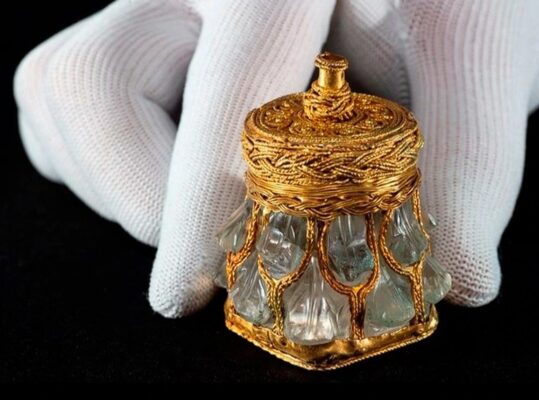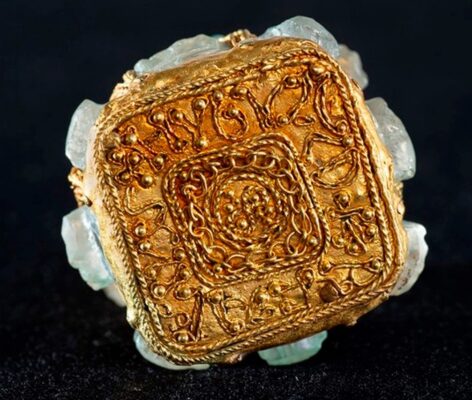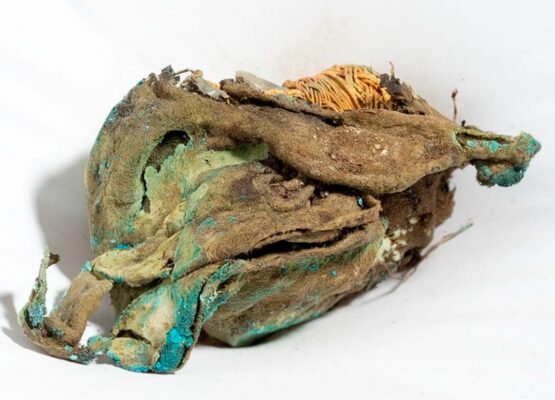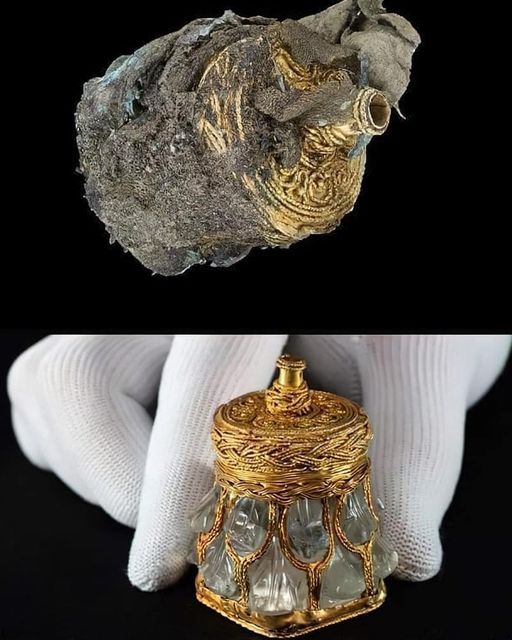The Roman rock crystal jar, a stunning artifact from the Viking era, is a remarkable piece of history. Discovered in 2014 as part of the Galloway hoard in a ploughed field in western Scotland, this jar offers an extraordinary glimpse into the craftsmanship and cultural connections of the time. In this article, we will explore the significance of the artifact, the restoration process, and the historical context of the find.
Follow archeology.dulichvn.net to learn more about mysterious artifacts.

Discovery of the Galloway Hoard
The Excavation Site in Western Scotland: Unearthing a Treasure Trove
In 2014, an ordinary ploughed field in the Galloway region of western Scotland became the focus of an extraordinary archaeological discovery. As a result of this serendipitous find, the Galloway hoard emerged as one of the most significant Viking-era hoards ever unearthed in Britain. The discovery of such an extensive collection of artifacts not only piqued the interest of archaeologists worldwide but also provided a unique glimpse into the material culture of the Viking Age. The field, once a quiet rural space, now holds a place in history, revealing the intricate connections and movements of people between the Roman and Viking periods.
Historical Significance of the Galloway Hoard: A Glimpse into the Past
The Galloway hoard was not just a random assortment of objects; it was a carefully concealed collection of valuables that had been hidden away for safekeeping during tumultuous times. Among the finds were a fascinating range of Viking and earlier Roman artifacts, including coins, weapons, jewelry, and religious items. These treasures were most likely buried during the late 9th century, a time when the region was subject to Viking raids and invasions. The hoard reflects both the wealth and the anxiety of the period—likely the result of a community seeking refuge from the chaos of war and plundering.
The hoard also highlights the deep cultural exchange between the Roman and Viking worlds. The Roman artifacts, some crafted centuries before the Viking settlements in Britain, demonstrate how Roman influence continued to impact the region long after the Roman Empire’s decline. This blending of cultures was not limited to material possessions but extended to the everyday lives of people living in Britain at the time. The Galloway hoard, therefore, offers valuable insight into the interactions between two of the most prominent civilizations in European history, bridging the gap between the Roman era and the rise of the Vikings.
The Role of the Roman Rock Crystal Jar: A Symbol of Cross-Cultural Influence
Amid the treasures uncovered in the Galloway hoard, the Roman rock crystal jar stands out as one of the most fascinating and unique finds. This small but significant artifact offers a rare connection to the Roman Empire, and its presence in a Viking hoard highlights the complex relationship between these two cultures. The jar, likely crafted during the Roman period, represents the high level of skill and craftsmanship associated with Roman artisans. It is believed that the jar was brought to Britain by the Romans, possibly as part of their long-standing trade networks that spanned much of Europe.
However, it is the jar’s use by Viking peoples that adds to its intrigue. By the time it was buried in the Galloway hoard, the jar had likely been in the possession of a Viking leader or community. The Vikings, known for their extensive raiding and trading routes, often incorporated Roman and other foreign items into their daily lives, either as symbols of wealth or as functional objects. The presence of the Roman rock crystal jar in the hoard thus serves as a testament to the Vikings’ ability to assimilate and repurpose items from different cultures, showcasing their adaptability and appreciation for fine craftsmanship.
In this context, the Roman rock crystal jar becomes more than just an artifact; it is a symbol of the blending of Roman and Viking influences. Its discovery not only sheds light on the Vikings’ material culture but also underscores the long-lasting impact of Roman civilization on the regions it once inhabited. The jar is a remarkable example of how the past continuously intersects with the present, offering us a tangible connection to the distant cultures that shaped modern Europe.

The Remarkable Restoration Process
Unveiling the Jar’s Intricate Design: A Masterpiece of Craftsmanship
Standing at a modest height of approximately 5 cm (2 inches), the Roman rock crystal jar captivates with its exquisite and intricate design. Despite its small size, this delicate artifact boasts an extraordinary level of craftsmanship, with its smooth rock crystal body wrapped in meticulously applied gold thread. The gold threads, spiraling around the jar in fine, precise coils, are a testament to the skill of master artisans who worked during the late eighth or early ninth century. Such detailed ornamentation was reserved for the finest objects, suggesting the jar was a cherished and highly valued possession.
The combination of rock crystal and gold thread highlights a fusion of Roman and Viking influences. The rock crystal itself, a rare and valuable material, reflects the Roman tradition of utilizing luxurious substances in their crafts, while the gold thread wrapping is more aligned with the ornate metalworking styles of the Vikings. The jar’s restoration process has helped uncover its original beauty, allowing the public to appreciate the intricate details that had been hidden by time and decay. Every twist of the gold, every facet of the crystal, speaks to the high level of artistry and craftsmanship that was involved in its creation.
Techniques Used in Restoration: Preserving a Fragile Treasure
Restoring the Roman rock crystal jar was a delicate, painstaking process, requiring the expertise of skilled conservators. The jar had suffered from centuries of wear, exposure to the elements, and the natural degradation of materials. To bring the artifact back to its original splendor, conservators employed a range of advanced restoration techniques.
First, the jar was carefully cleaned, with special attention paid to the fragile rock crystal surface. Cleaning was done with non-invasive methods to remove dirt and grime without damaging the delicate material. Once cleaned, the jar was stabilized to ensure that the rock crystal and gold threads remained intact and did not suffer further damage. Stabilizing the gold thread wrapping was a particularly challenging task, as the fine thread had begun to loosen in places. Using precision tools and techniques, experts were able to reattach and reinforce the gold, ensuring its longevity.
Finally, the preservation process focused on ensuring the jar’s structural integrity for future display. Protective coatings were applied to safeguard the rock crystal and gold, preventing further degradation while allowing the jar to be showcased in its restored form. The jar now stands as a testament to the meticulous work involved in preserving historical artifacts, allowing it to continue inspiring awe and appreciation for generations to come.
Preservation for Future Generations: Safeguarding a Historical Treasure
The Roman rock crystal jar, now fully restored, is more than just an ancient relic—it is a treasured artifact that has been carefully preserved for future generations. The preservation efforts not only safeguard the physical integrity of the jar but also ensure that its historical and cultural significance is not lost to time.
As a product of both Roman and Viking craftsmanship, the jar serves as a vital link between two powerful cultures that shaped the course of European history. Its restoration has made it possible for modern audiences to witness firsthand the exceptional artistry of these ancient civilizations. By preserving this unique artifact, we can continue to learn from it, gaining insight into the cultural exchange, trade, and craftsmanship that flourished during the Viking Age and Roman era.
The jar is now more than just an object on display; it is a piece of history that will continue to educate and inspire. Its preservation is a reminder of the importance of protecting and safeguarding artifacts from the past, allowing them to contribute to our understanding of history for generations to come.

See more: Meroë: The Forgotten City of Pyramids in the Sudanese Desert
The Craftsmanship Behind the Artifact
Gold Thread Wrapping: A Symbol of Mastery and Prestige
One of the most remarkable aspects of the Roman rock crystal jar is its intricate gold thread wrapping, which immediately captures the attention of anyone who views it. The fine gold thread, carefully coiled and wrapped around the crystal, not only adds an element of visual brilliance but also speaks volumes about the exceptional craftsmanship involved in its creation. The artisans who worked on this piece demonstrated not only technical skill but an artistic flair that elevated the jar from a mere functional object to a remarkable work of art.
The use of gold in the design is particularly significant, as it indicates the high status of the jar’s owner or suggests its ceremonial importance. Gold, as a precious material, was often reserved for elite individuals or sacred objects during this period. The delicate yet durable nature of the gold thread not only enhances the jar’s aesthetic appeal but also reflects the value placed on both its craftsmanship and its symbolic meaning. The gold thread wrapping, with its meticulously applied coils, marks the jar as a luxury item, intended to be admired and perhaps used in rituals or ceremonies that required objects of rare beauty and fine craftsmanship.
Viking and Roman Craftsmanship Combined: A Fusion of Cultures
The Roman rock crystal jar is a striking example of the blending of two powerful artistic traditions—those of the Romans and the Vikings. The rock crystal itself, a rare and valuable material, is indicative of Roman influence, showcasing the advanced skills of Roman craftsmen who worked with fine materials and precious stones. The Romans were renowned for their ability to craft items from materials like crystal, marble, and glass, demonstrating a sophisticated level of artistry and technique.
However, the gold thread wrapping that adorns the jar is a distinctly Viking addition, showcasing their renowned skill in metalwork. The Vikings, famous for their intricate designs and fine metal crafting, often utilized gold and silver in their creations, with gold thread being a common feature in their more elaborate works. The combination of these two elements—the Roman rock crystal and the Viking gold thread—demonstrates the complex cultural exchange between the Roman Empire and the Viking world. It highlights how the Vikings not only encountered but also embraced Roman craftsmanship, incorporating Roman materials and techniques into their own artistic traditions.
This fusion of Roman and Viking artistry is not just an aesthetic feature but also a reflection of the cultural and commercial interactions between these two civilizations. It underscores the idea that cultural boundaries were fluid, and goods, ideas, and artistic techniques traveled across regions, blending over time to create hybrid forms of material culture.
The Historical Context of Viking Artifacts: Insight into Viking Craftsmanship
Artifacts such as the Roman rock crystal jar offer invaluable insights into the material culture of the Viking Age. During this period, Viking artisans were renowned for their extraordinary metalworking skills, producing exquisite jewelry, weapons, and everyday items. Often using precious materials such as gold, silver, and bronze, Viking craftsmen elevated even the simplest objects into beautiful and highly functional works of art.
The gold thread wrapping on the rock crystal jar is a perfect example of Viking metalwork. The precision and intricacy of the technique showcase the high level of expertise that Viking artisans possessed, as well as their ability to work with precious materials. Viking metalworkers were adept at combining form and function, creating pieces that were not only aesthetically pleasing but also durable and meaningful.
In addition to their technical mastery, Viking artisans were also influenced by the diverse cultures they came into contact with through their far-reaching trade networks, raids, and exploration. The presence of Roman materials and techniques in Viking artifacts like this jar reveals the extent of the cultural exchange that occurred between the two civilizations. The jar serves as a tangible connection to a time when Viking and Roman influences blended, enriching the artistic traditions of both cultures.
By studying artifacts such as this, we gain a deeper understanding of the Viking world—not just their craftsmanship but also their trade routes, cultural interactions, and the symbolism embedded in their art. The rock crystal jar, with its fusion of Roman and Viking styles, helps us piece together the intricate web of historical and cultural connections that shaped the Viking Age.

Conclusion
This Roman rock crystal jar, with its impressive restoration and intricate design, provides a fascinating glimpse into the Viking era. From its discovery in the Galloway hoard to its careful restoration and preservation, the jar highlights the artistic mastery of the period and the cultural connections that shaped the world of the Vikings.


CÁC TIN KHÁC
Mary Walton: The Forgotten Inventor Who Helped Clean Up America’s Cities
Tomb of Queen Nefertari in the Valley of the Queens, Egypt
Discover the Hypostyle Hall of the Temple of Hathor at Dendera
Venus de Losange: Unveiling the Mystery of a 20,000-Year-Old Paleolithic Icon